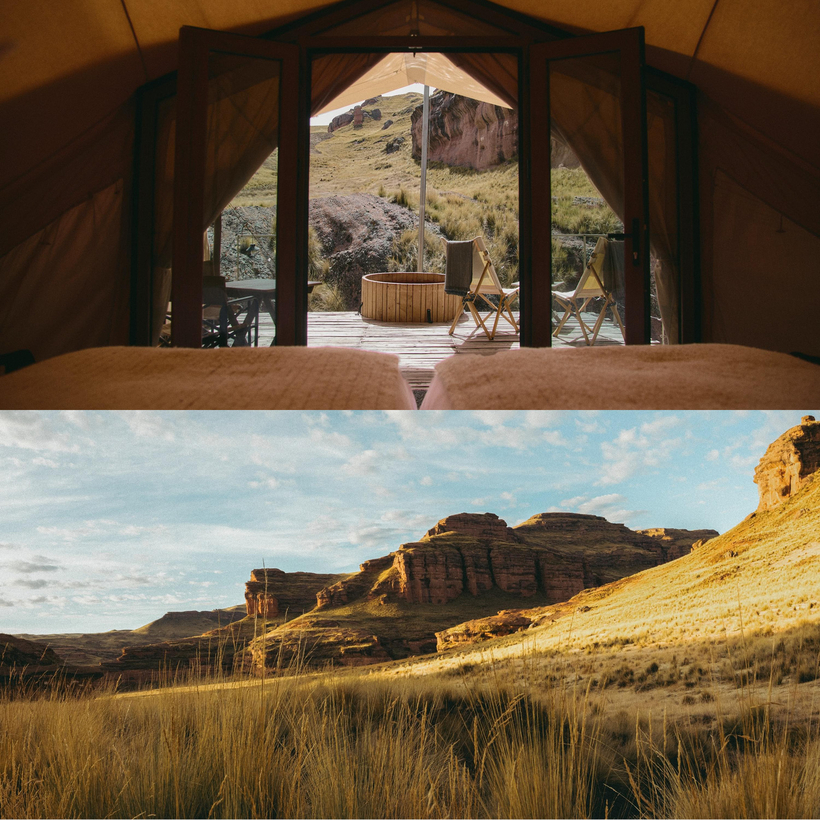Halfway between Cuzco and Lake Titicaca, in southern Peru, a track leads upward through a wide valley in the Andes Mountains, golden with the grasses of the Altiplano.
At its far end, the valley is enclosed by red sandstone cliffs—rock walls, towers, and outcrops the size of office buildings, smoothed and sculpted by millennia of wind and water.
The name of the place, Tinajani, means “stone vessel” in Quechua, a regional dialect. Pre-Inca peoples believed the rock formations resembled giant earthen jugs, left here by gods.

Nestled in this sandstone amphitheater, in a region so remote that it’s a two-hour drive from the nearest airport (Juliaca), is an old sheep ranch. It has found a new life as a high-end boutique hotel, called Tinajani, which opened in June.
Fanning out from a cluster of adobe farm buildings stand six spacious campamentos—safari-style tents—set on wooden decks. This is glamping so luxurious one would be forgiven for forgetting these are tents, given the luxury bedding, sheepskin rugs, glorious showers, cushioned divans, wood-burning stoves, and antique chests.

The magnificent gallery of towering red rock formations makes for excellent views. They can be enjoyed from almost every vantage point at the lodge, including the beds and the wooden hot tubs on the front decks. At night, the cliffs are softly illuminated, rearing up into a sky packed with constellations.
The old estancia buildings have become the lodge’s communal spaces. The living room feels like an Edwardian country house with faded South American rugs, a chaise lounge, a carved sideboard, antique cookware, table linens as heavy as curtains, lamps with parchment shades, and a hat stand. Sepia photos of men who came here a century ago to make their fortune from sheep, seated on horseback in three-piece suits and high collars, line the walls.

Tinajani is the latest creation of Andean, a small group of luxury properties that include two in Lima and four in southern Peru. All are stylish and atmospheric, with an understated vintage charm. Cirqa, in Arequipa, is an old monastery with barrel ceilings and freestanding bathtubs. At Titilaka, on Lake Titicaca, guests look up from dinner through glass walls to views of the lake and the mountains of Bolivia. In Ātemporal, in Lima, one seems to have dropped through a rabbit hole into an elegant, 1920s expatriate’s home.
Food is central to them all. At Tinajani, the chefs use ingredients and recipes rooted in pre-Colombian Andean cuisine. The hearty rural dishes change with the seasons and are accompanied by ancient grains such as quinoa and cañihua.
Some ingredients are unfamiliar to many travelers, but they’re wonderful, especially tarwi, a bean known in English as Andean lupin, and lucuma, a fruit with yellow flesh whose taste is somewhere between butterscotch and maple syrup.

I still remember the meals, the al dente potatoes served with a light chili sauce; the trout carpaccio, dressed with lime and capers and olive oil, served with small triangles of toast.
But most of all I remember the hot tub, the lanterns lit on the deck outside the tent, the deep silences of that rock amphitheater, and the dark skies swarming with stars.
The writer was a guest of the travel specialists Dehouche. A five-night itinerary in Peru, including two nights at Ātemporal, a curator-led tour in Lima, and three nights at Tinajani, with meals, transfers, and domestic flights, starts at $3,480 per person
Stanley Stewart, a journalist based in Dorset, U.K., and Rome, is a contributing editor at Condé Nast Traveler and a regular contributor to The Sunday Times of London. He is a fellow of the Royal Society of Literature, and his most recent book is In the Empire of Genghis Khan

